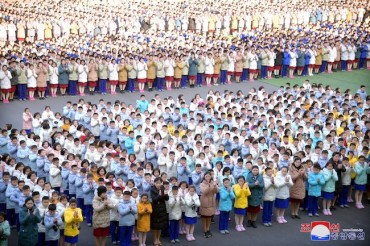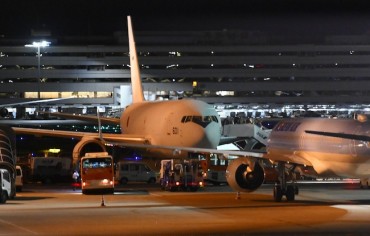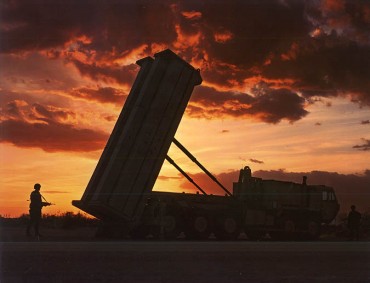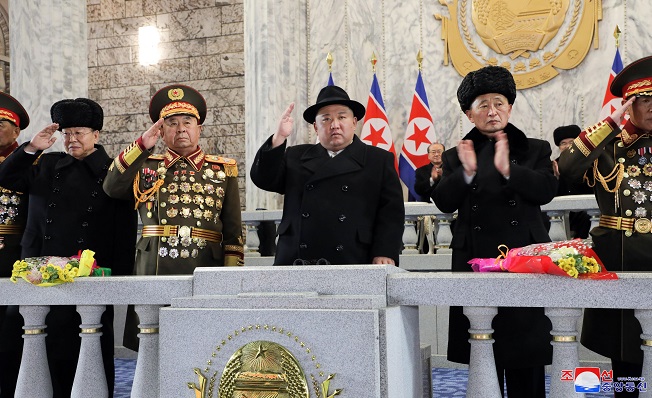
This photo, carried by North Korea’s official Korean Central News Agency on Feb. 9, 2023, shows North Korean leader Kim Jong-un (C) overseeing a military parade in Pyongyang the previous day to mark the 75th founding anniversary of the North’s armed forces. (Yonhap)
SEOUL, Feb. 9 (Korea Bizwire) — North Korea has staged a massive military parade in Pyongyang to mark the 75th founding anniversary of its armed forces, its state media confirmed Thursday, describing intercontinental ballistic missiles (ICBMs) on display as representing the country’s “maximum nuclear attack capabilities.”
Its leader Kim Jong-un attended the nighttime event, held Wednesday, along with his wife, Ri Sol-ju, and apparent second child, Ju-ae, according to the North’s official Korean Central News Agency (KCNA).
There has been no report on whether he delivered a public speech.
Flanked by top military and party officials, Kim took to the reviewing stand to watch the parade held in Kim Il Sung Square to celebrate the Korean People’s Army (KPA) anniversary.
Clad in a long black coat and wearing a felt hat, Kim saluted back, photos released by the KCNA showed. His outfit was reminiscent of those of the country’s late founder, Kim Il-sung, who is known as his role model.
In particular, the KCNA reported a column of ICBMs rolled through the square, demonstrating the regime’s “revolutionary” development of military power and its “maximum” nuclear attack capability.
Also appearing at the parade were columns of “tactical” missiles and long-range cruise missiles, it added.
The North, moreover, presented “tactical nuclear units” in a demonstration of its “war deterrence and counterstrike capabilities.”
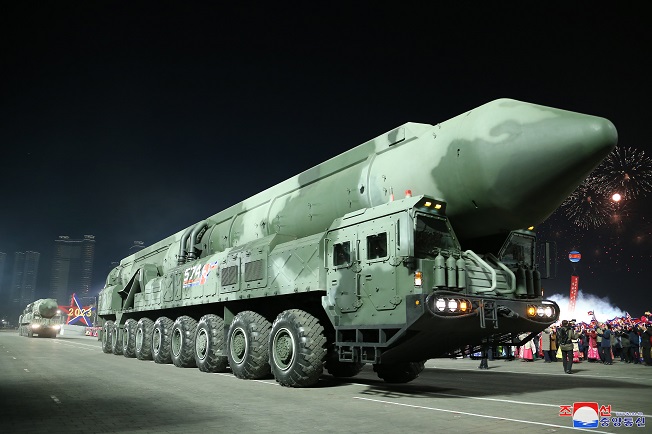
This photo, carried by North Korea’s official Korean Central News Agency on Feb. 9, 2023, shows a suspected solid-fuel intercontinental ballistic missile (ICBM) showcased at a military parade in Pyongyang the previous day to mark the 75th founding anniversary of the North’s armed forces. (Yonhap)
Photos of the parade showed Hwasong-17 ICBMs, as well as what is presumed to be a new ICBM mounted on a transporter erector launcher (TEL) with 18 wheels.
The specifics of the new missile remains unknown, but its presence raised speculation that it could be a solid-propellant missile that the North has been striving to secure.
In December last year, the North claimed to have successfully conducted a test of a “high-thrust solid-fuel” rocket motor to develop a “new-type strategic weapon” — a move that reinforced speculation about its push for a solid-fuel ICBM.
If deployed, a solid-propellant ICBM could pose a significant threat to the U.S. mainland given that it can enable a surprise attack as it takes less preparation time to launch than a liquid-fuel one, which requires time-consuming pre-launch procedures like the injection of fuel.
The parade also featured a range of missiles and artillery pieces that can target South Korea.
They included “super-large” multiple rocket launchers and 152 mm-caliber self-propelled howitzers, as well as the KN-23 missile modeled after Russia’s Iskander ballistic missile.
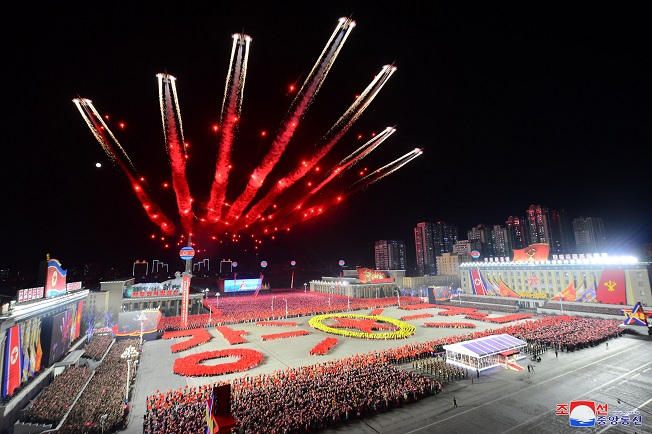
This photo, carried by North Korea’s official Korean Central News Agency on Feb. 9, 2023, shows the North staging a military parade in Pyongyang the previous day to mark the 75th founding anniversary of its armed forces. (Yonhap)
Later in the day, the North’s Korean Central Television aired recorded footage of the parade.
Kim’s daughter Ju-ae was seen walking close to the leader on the reviewing stand, adding to a debate over whether she could be groomed as Kim’s successor.
Ju-ae was first exposed to the public eye in November last year, as the North’s state media released photos showing her and the leader attending the test-firing of a Hwasong-17 ICBM.
Some observers have dismissed the possibility of Ju-ae having any potential to become a hereditary successor, given the North’s patriarchal society and the apparent existence of Kim’s eldest son.
The secretive regime has ramped up efforts to advance its weapons program in defiance of multiple U.N. sanctions on the North.
At a party meeting late last year, Kim Jong-un called for an “exponential” increase in its nuclear arsenal, raising the need to mass-produce tactical nuclear weapons apparently targeting the South and to develop a new ICBM.
The North fired around 70 ballistic missiles, including eight ICBMs, last year alone, the most in a single year. Those ICBMs included presumed Hwasong-17 missiles.
Since Kim took power following his father’s death in late 2011, his regime has staged 13 military parades, including the latest one.
(Yonhap)



